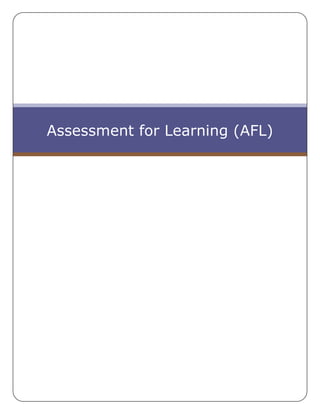
Assessment For Learning (Afl)
- 1. Assessment for Learning (AFL)<br />Assessment for Learning (AFL)<br />It is vitally important for students to understand how well they are doing and what they need to do in order to improve and achieve the highest grades they possibly can. Assessment for Learning (AFL) is the term used to describe this and examples of how we encourage / develop AFL within the Business & Economics Faculty are included below.<br />Firstly, it should be known that all examples of good or great practice listed below generally fall within QCA guideline definitions of what AFL looks like in practical terms, namely;<br />Use of effective questioning techniques in the classroom<br />Use of marking and feedback strategies (see next ‘Sharing Great Practice’ item for more details)<br />Sharing of learning goals with students and parents<br />Peer and self-assessment (students constructively analysing their own and each other’s work)<br /> <br />Use of effective questioning techniques in the classroom<br />High-level questioning can be used as a tool for assessment for learning. Teachers can:<br />use questions to find out what pupils know, understand and can do <br />analyse pupils' responses and their questions in order to find out what they know, understand and can do <br />use questions to find out what pupils' specific misconceptions are in order to target teaching more effectively <br />use pupils' questions to assess understanding.<br />Examples of questions used by Teachers within EBIT and across the school include<br />how can we be sure that...? <br />what is the same and what is different about...? <br />is it ever/always true/false that...? <br />how do you...? <br />how would you explain...? <br />what does that tell us about...? <br />what is wrong with...? <br />why is...true?<br />Exam Question are also regularly given to all our students and these help both prepare students for the real thing and help us to assess learning gaps. We can also provide good writing frames so that answers become fully developed.<br />4055110222885Sharing of Learning goals with students and parents<br />41090852042795In the pictures to the right you will see just a few examples of how we share learning goals with students. Firstly you can see assessment grading criteria permanently taped to a table for students and the teacher to refer to as they move around the classroom (this is also copied to personal folders so that students have a permanent record of what they are doing and what they need to do to get higher grades). Secondly, grading criteria within a personalised folder and highlighting of the current topic. Thirdly, missing work necessary to complete a particular grading criteria listed on the left hand side of the main lesson plan for the day. We also use numerous electronic spreadsheets and databases to do this same task. We keep parents involved by submitting information onto our SIMS database for Progress Days. We also hold regular meetings with Parents and in some cases publish performance data online (using codes known only to parents so that student names are not made public). Target and current grades are also recorded in Student Planners which go home to parents each day. Target marking in books is also common practice (at the end of each enquiry in GCSE Business & Economics for example). <br />24765052070329565071120<br />Use of Peer and self-assessment<br />292735148907533153351049655This is a regular feature of lessons within the Department. In the photos below you can see students completing the task of checking whether each other’s pictures match the definitions given on the board. Students can advise each other of mistakes before they are glued permanently onto paper and stored in their folders (Year 12 Skills for Working Life pictured with Teacher Pat Johnson).<br />An increasingly common practice in EBIT and across the School is the use of “Think Pair Share” –<br />Ask your students to get together in pairs. If need be, have some of the students move. If you have an odd number of students, allow one group of three. It's important to have small groups so that each student can talk. Open-ended questions are more likely to generate more discussion. <br />Ask a question. <br />Give students a minute to two (longer for more complicated questions) to discuss the question and work out an answer. <br />Ask for responses from some or all of the pairs.<br />Examples of think-pair-share questions include: <br />Describe and interpret the image. <br />Before we start talking about the global credit crunch, have there been periods of economic downturn like this in the past? If so, when did such periods occur and what is the evidence? <br />From the data provided, what was the break-even point? <br />What kinds of jobs do you think require people with knowledge of marketing strategies? <br />You can use the student responses as a basis for discussion, to motivate a lecture segment, and to obtain feedback about what your students know or are thinking.<br />Write-pair-share, a variation of think-pair-share, gives students a chance to write down their answer before discussing it with their neighbor. You may wish to collect written responses from each student or each pair before or after discussing the answer. <br />Advantages of the think-pair-share technique are that <br />it's quick <br />it doesn't take much preparation time <br />the personal interaction motivates many students with little intrinsic interest in science <br />you can ask different kinds and levels of questions <br />it engages the entire class and allows quiet students to answer questions without having to stand out from their classmates. <br />you can assess student understanding by listening in on several groups during the activity, and by collecting responses at the end<br />
